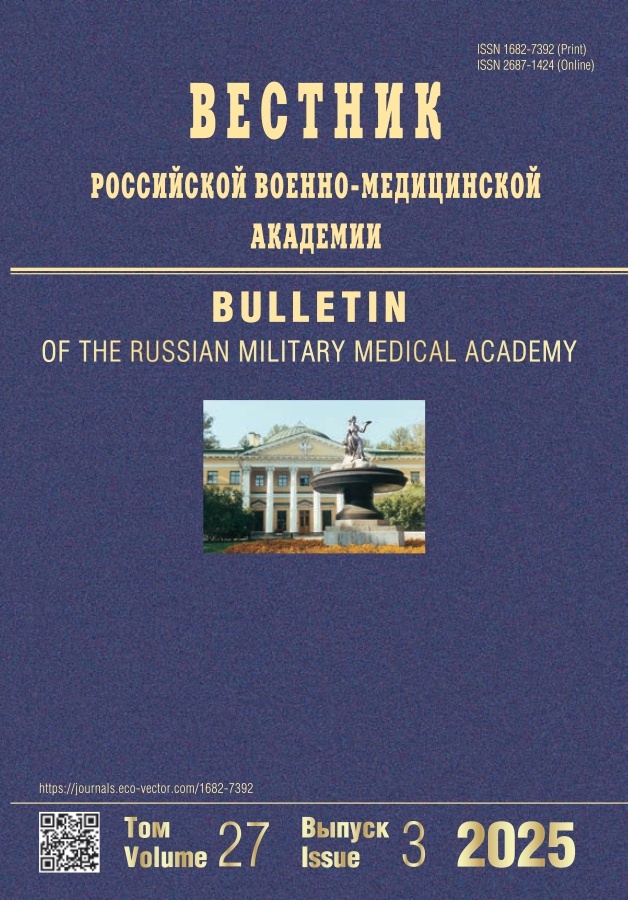Clinical and epidemiological aspects of human toxocarosis in the Astrakhan region
- Authors: Arakelyan RS1, Okunskaya EI2, Shendo GL2, Polyakov VK2, Almukhambedova AR3, Ityaksova VA3, Saltereyev SR4
-
Affiliations:
- Астраханский государственный медицинский университет
- Детская городская поликлиника № 3
- Центр гигиены и эпидемиологии в Астраханской области
- Областное патологоанатомическое бюро г. Астрахани
- Issue: Vol 21, No 2 (2019)
- Pages: 70-73
- Section: Articles
- URL: https://journals.rcsi.science/1682-7392/article/view/25922
- DOI: https://doi.org/10.17816/brmma25922
- ID: 25922
Cite item
Full Text
Abstract
Full Text
##article.viewOnOriginalSite##About the authors
R S Arakelyan
Астраханский государственный медицинский университет
Email: rudolf_astrakhan@rambler.ru
Астрахань
E I Okunskaya
Детская городская поликлиника № 3Астрахань
G L Shendo
Детская городская поликлиника № 3Астрахань
V K Polyakov
Детская городская поликлиника № 3Астрахань
A R Almukhambedova
Центр гигиены и эпидемиологии в Астраханской областиАстрахань
V A Ityaksova
Центр гигиены и эпидемиологии в Астраханской областиАстрахань
S R Saltereyev
Областное патологоанатомическое бюро г. АстраханиАстрахань
References
- Божко, Г.Г. Встречаемость яиц токсокар в песочницах города / Г.Г. Божко [и др.] // Совр. пробл. науки и образ. - 2016. - № 4. - С. 212.
- Боткина, А.С. Токсокароз у детей / А.С. Боткина // Практика педиатра. - 2015. - № 2. - С. 4-8.
- Глазунова, Л.В. Токсокароз у детей / Л.В. Глазунова [и др.] // Лечебное дело. - 2008. - № 1. - С. 69-73.
- Думбадзе, О.С. Токсокароз - актуальный гельминтоз для Рос- сии / О.С. Думбадзе [и др.] // Дальневост. журн. инфекц. патологии. - 2017. - № 33 (33). - С. 39-42.
- Кувайцева, Н.Г. Токсокароз глаз у детей / Н.Г. Кувайцева [и др.] // Росс. педиатр. офтальмолог. - 2013. - № 1. - С. 65-67.
- Нестерова, Ю.В. Токсокароз - важная проблема для Приморского края / Ю.В. Нестерова [и др.] // Дальневост. журн. инфекц. патологии. - 2017. - № 33 (33). - С. 43-45.
- Никулина, М.А. Токсокароз: клинико-эпидемиологическая характеристика / М.А. Никулина [и др.] // Дальневост. журн. инфекц. патологии. - 2012. - № 21 (21). - С. 172-175.
- Старостина, О.Ю. Токсокароз: современное состояние проблемы в Российской Федерации. Сообщение 2: Заболеваемость населения токсокарозом в различных административных территориях Российской Федерации 72 2 (66) - 2019 ВЕСТНИК РОССИЙСКОЙ ВОЕННО-МЕДИЦИНСКОЙ АКАДЕМИИ Клинические исследования / О.Ю. Старостина [и др.] // Эпидемиология и вакцинопро- филактика. - 2015. - Т. 14, № 3 (82). - С. 54-58.
- Чернова, Т.М. Проблема гельминтозов в педиатрии. Токсокароз. Что делать? / Т.М. Чернова // Мед. совет. - 2015. - № 4. - С. 73-76.
- Чернова, Т.М. Токсокароз в практике детского врача / Т.М. Чернова [и др.] // Педиатр. - 2010. - Т. 1, № 2. - С. 119-124.
- Шипкова, Л.Н. Токсокароз в Краснодарском крае / Л.Н. Шип- кова [и др.] // Теория и практика борьбы с паразитарными болезнями. - 2016. - № 7. - С. 532-534.
- Щевелёва, Т.Н. Токсокароз, особенности эпидемиологии (обзор литературы и собственные исследования) / Т.Н. Щевелева [и др.] // Научное обозрение. Мед. науки. - 2016. - № 6. - С. 124-128.
Supplementary files







